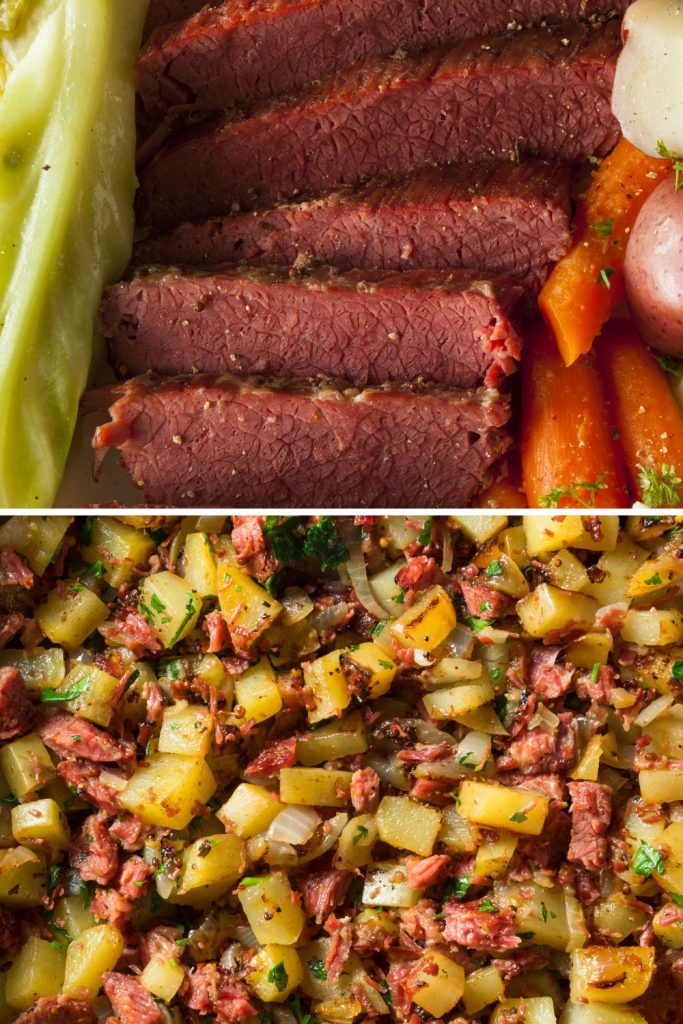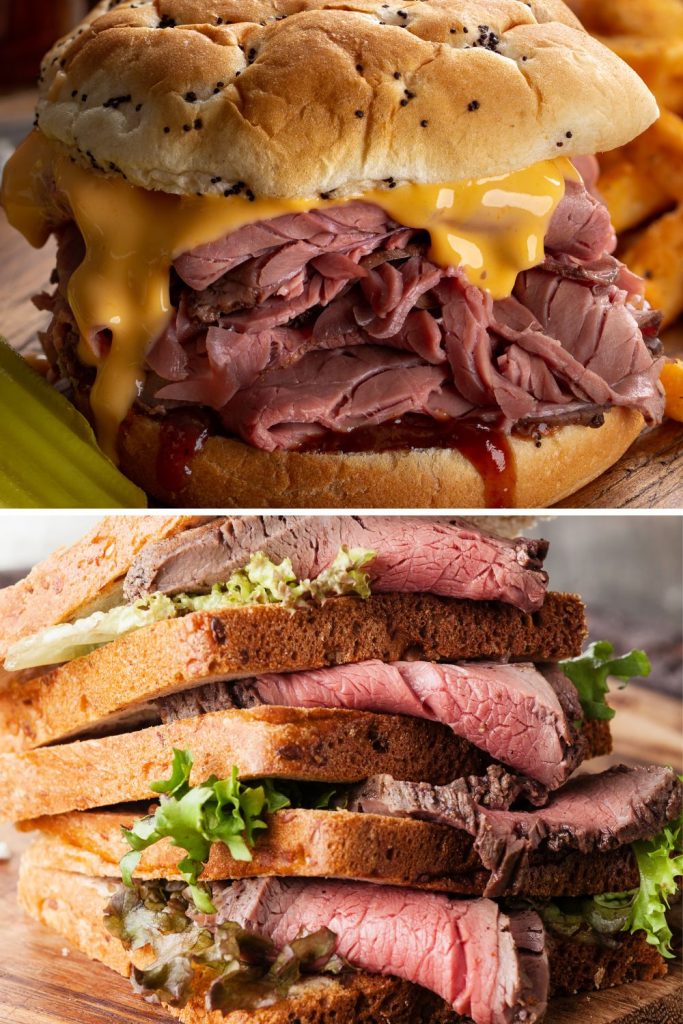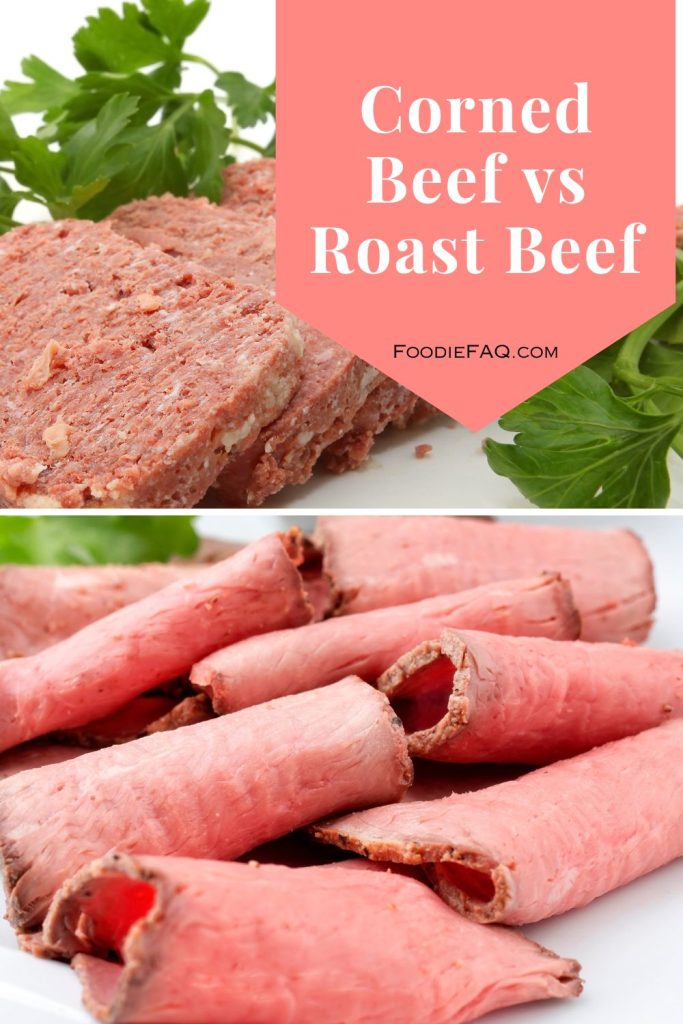Have you ever found yourself standing in the meat section of the grocery store staring down, trying to decide corned beef vs roast beef?
I have, and it is a bit confusing, to be honest. When you look at the corned beef, it tends to have peppercorns in the packaging, and it looks juicy. The roast beef looks dry and bright red. What is this all about? Why do they look so different yet oddly similar?
I get it because I was confused, too. Well, now you get to learn what I have learned.

Understanding A Bit About Corned Beef
What Is Corned Beef?
Corned beef is a cut of beef, usually brisket, that’s been cured or pickled in a seasoned brine.
The term “corned” comes from the large grains of salt historically used in the curing (also called “corning”) process.
Flavor and Texture
Corned beef doesn’t contain any corn, and it doesn’t taste like corn.
Corned beef is known for its distinctive pink color, tender texture, and tangy flavor. The curing process gives it a salty, briny, and slightly spicy flavor profile.
Corned beef stays bright pink in color because the salt fixes the color.
When you buy a corned beef roast at the store, you may notice the small dots of peppercorns in the pink brine. They add to the flavor but are generally disposed of after rinsing and cooking the roast.
Uses of Corned Beef
It’s the star in corned beef and cabbage, a staple for St. Patrick’s Day.
It’s also popular sliced thin and piled high on sandwiches, particularly in the Reuben and the Rachel (no sauerkraut)and in corned beef hash, a popular breakfast dish that contains diced potatoes.
Fun Fact: The “corn” in corned beef refers to the large grains of salt historically used in the curing process.

Understanding A Bit About Roast Beef
What is Roast Beef
Roast beef is a cut of beef that has been cooked by roasting. Roast beef is generally quite lean, which just means that it isn’t filled with fatty strips going through it. It is often served as a main dish and is famous for being the center of the table for a family gathering.
There are quite a few different types of roast beef sold at the grocery store. There is a sirloin top roast, rump roast, chuck roast, and more. In the end, though, just know that it is a lean type of meat that is best cooked in a slow roasting method.
Flavor and Texture
The texture of roast beef will depend greatly on how it was cooked. If cooked using the slow and low method, it will tend to turn out tender and juicy. In this instance, you can get that lovely melt-in-your-mouth feel that roast beef is famous for.
It is also excellent at absorbing the flavors of the seasonings that you add. Roast beef has a robust and meaty flavor.
Uses of Roast Beef
Roast beef is a classic Sunday meal. Growing up, I knew that it was a special day if I saw the crockpot out and there was a roast beef with cut-up veggies in it.
It makes epic leftover meals, too. Roast beef sandwiches are legendary and a fantastic way to use up some leftovers.
You can also make a delicious has with roast beef. Fry up some eggs to go alongside your roast beef hash, and you have an amazing brunch in the making.

Corned Beef vs Roast Beef
Ingredients and Preparation
While both types of meat start with beef, their preparation methods differ significantly. Corned beef is brined for about a week, giving it a salty, tangy flavor.
Roast beef is seasoned with herbs and spices like garlic, onion, oregano, and rosemary. It is then slow-roasted in an oven or slow cooker.
Roast beef will have a more meaty flavor in the end compared to the tangy flavor of corned beef. They are both cuts of beef, but the end result is dramatically different.
Flavor and Texture
The texture of Corned beef and roast beef can be quite similar, which is tender and juicy. The real difference between the two is in the flavor.
Corned beef’s brining process results in a tangy, salty flavor. Roast beef, however, has a robust, meaty flavor and sometimes is slightly sweet in comparison to corned beef especially.
It is important to keep in mind that the flavor of roast beef will vary quite a bit depending on how you season it. Corned beef will generally taste the same no matter who prepared it.
Storage and Shelf Life
Both meats can be stored in the refrigerator for a few days. Corned beef, due to its brining process, can last a bit longer than roast beef. You can also freeze corned beef and roast beef.
Saltiness
Corned beef tends to be saltier due to the brine. It is soaked in a mixture of salt water, which is what brined means in this instance. There are other seasonings and flavors added to the brine, but by the simple nature of how corned beef is created, it is extremely salty, especially in comparison to roast beef.
Roast beef will only be salty if it is seasoned with salt or a seasoning that includes salt.
Cooking Tips
For corned beef, consider slow-cooking it in a crockpot with some beer or broth. For roast beef, roasting it in the oven at a low temperature will help achieve a tender, juicy roast. When choosing between the two, consider the flavor profile you’re after and the dish you’re making.
The bottom line
Whether you’re team corned beef or team roast beef, both types of meat have their own unique qualities and uses in the kitchen.
From the tangy, tender corned beef to the robust, juicy roast beef, your choice will depend on the flavor and texture you’re after.
So next time you’re at the grocery, why not pick up both and have yourself a beefy feast?

